How to.. Get more people to recycle.
Our group was given the topic of recycling.We began by discussing the different existing menthods of recycling which we wee already aware of. As recycling is already a subject matter which most people are familiar with, we tried to think more specifically about areas of research which were less commonly taken into consideration. Our initial notes consisted of:
Charity shops
Vintage shops
Online recycling - eg. Ebay, Freecycle
Online information resources - e.g. Recyclenow
Compost
Greenware Clothing
Recyclyable material
Non-recyclable material
From this list we were all given individual topics to extensively research. We were asked to produce three research boards: primary research, secondary research and a third showing the research which we found most interesting/effective.
My topic was
online recycling.
As primary research I wanted to discover on average in a group of
32 students aged
18-21 how many people used
ebay and if so why?.. The results showed that
three quarters of this group used ebay because they were able to find good second-hand items at a low price. From this research I was able to get an idea of how popular online recycling methods such as ebay are.
As secondary research I moved away from ebay and began looking into online information resources such as recyclenow. This was useful for my research development as it gave a me a greater knowledge of how much information is accessible to the public and how easy this information is to find. Generally there were a vast amount of websites informing, advising and encouraging a variety of ways to recycle. However, one of the main things I began to notice was the repetitive manners in which the information was delivered/displayed. Each website followed the same, safe and predictable structure, causing my engagement and interest to fade quickly.
As further secondary research I began looking at various images on Pinterest and Tumblr. This was to see how other people have approached recycling in a more unusual manner. One of the main images that caught my attention was the imaginative uses of info graphics:
On friday we presented our research boards to the rest of the group. We then generated a new set of ideas based on what schemes we thought would be most interesting, unusual and beneficial to our target audience. During her research, Anisha looked into big brand recycling and discovered that although many companies were supporting recycling and making attempts to tackle this, they did not advertise this particularly well.
We found this topic most interesting and therefore began discussing various well-known brands who either already recycle and do not advertise well or do not approach recycle as much as they could do.
We decided to al focus on different brands and research specifically into they're recycling methods and advertising. I was given Coca-cola.
I placed a collection of different bottles and cans in the shape of a Coca-Cola bottle and then took a series of photographs shown below:
I then experimented with different adjustments of each layer in Photoshop.
Here I wanted to discover how effective it would be to combine my work with the existing Coca-Cola glass bottle.
Using the original bottle as a template, I deleted my image to fit within this exact shape. Although I was pleased with this outcome, I found the logo distracting. As I was aiming to achieve the resemblance of the bottle shape without the logo I decided to keep the shape of the glass bottle but remove this layer.
Below is a screenshot of four of our final poster designs: left to right: Adidas, Nike, Apple & Coca-Cola
As an information source explaining the intentions of our products we generated a concertina-stlye leaflet. On one side was the five original logos and a short description explaining their involvement. On the other was our own recreated versions of these brands.
Final Concertina Front
Final Concertina Back





































































